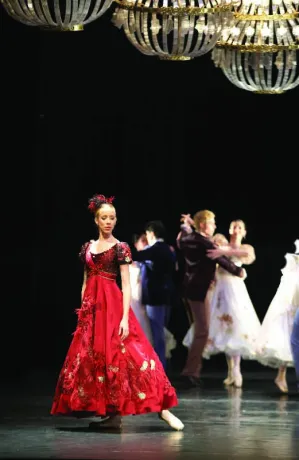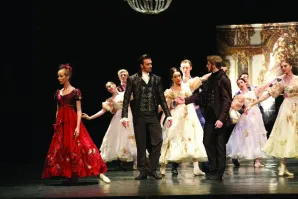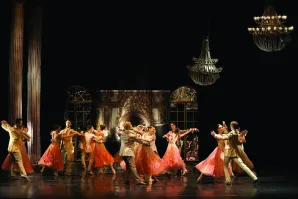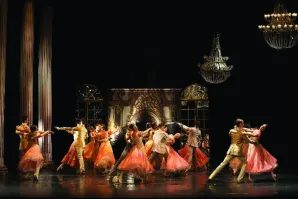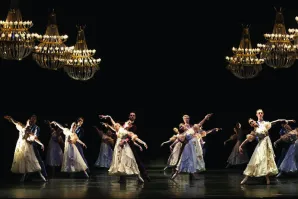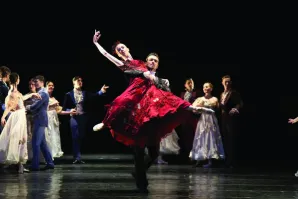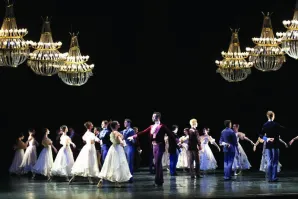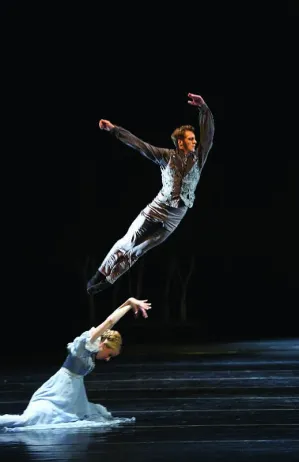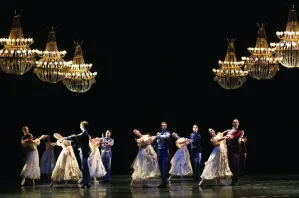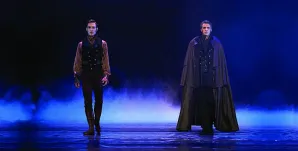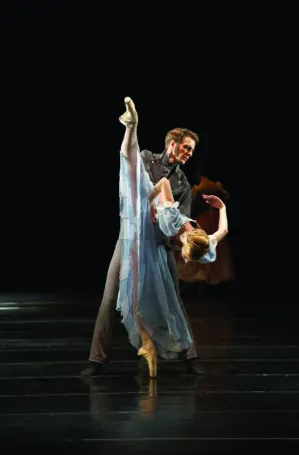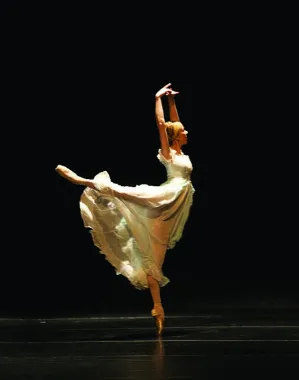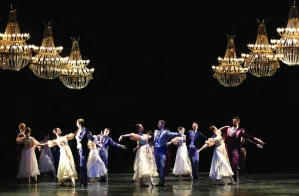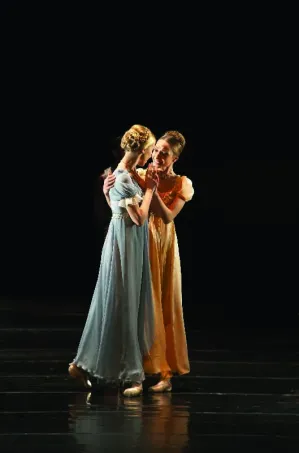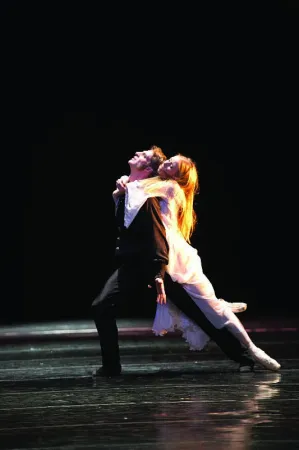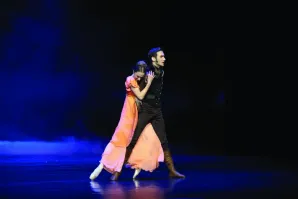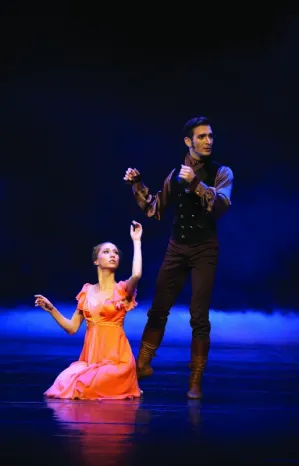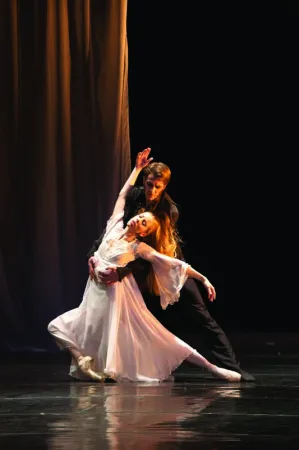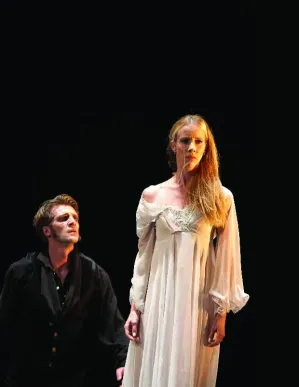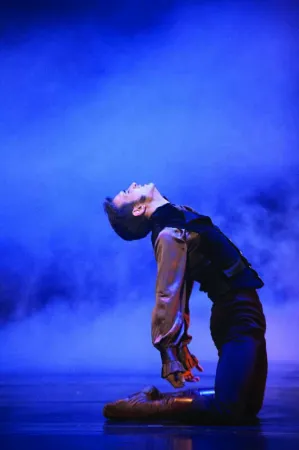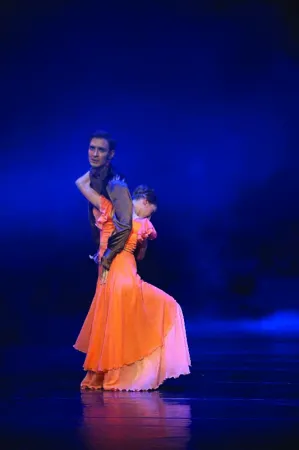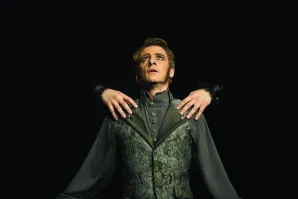Eugene Onegin
ballet by P. I. Tchaikovsky
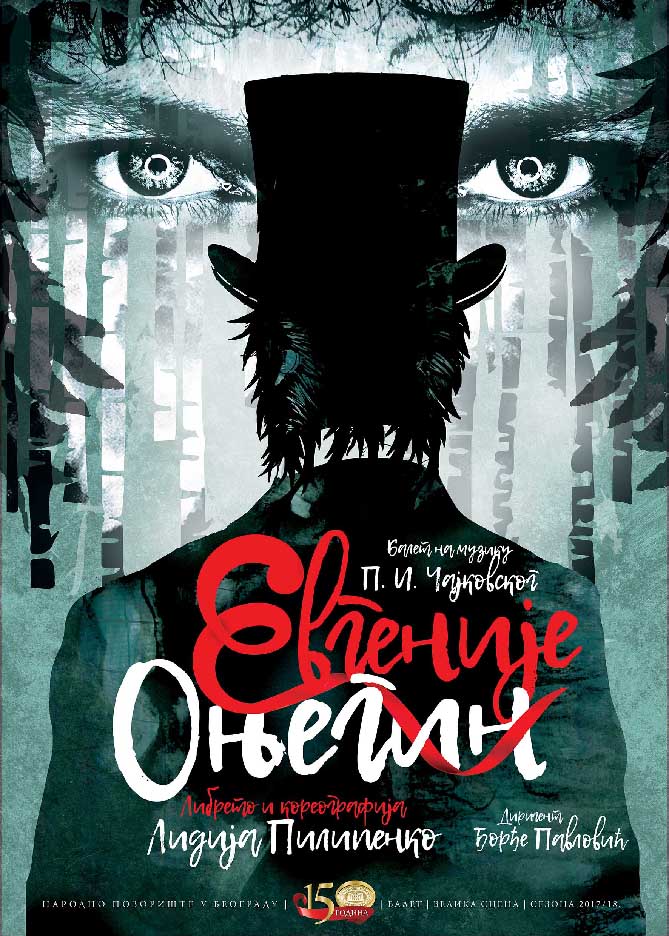
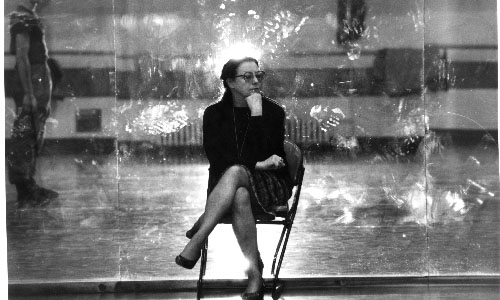 Lidija Pilipenko
Lidija Pilipenko
An artist, prima ballerina and choreographer, spent most of her professional life at the Ballet Company of the National Theatre in Belgrade. After her specialization in London with Ninette de Valois and a brilliant career in the profession, she ventured into choreography. Already having an outstanding career as a prima ballerina of the National Theatre Ballet, she proved herself to be one of the top choreographers in the country. She created the following ballets to the music of Yugoslav composers: Banović Strahinja and Jelisaveta by Zoran Erić for the Belgrade Theatre, The Eternal Bachelor, and The Choosy Girl by Zoran Mulić for the Theatre in Novi Sad. In 1981, at the Biennale in Ljubljana she received the Award for Choreography for Banović Strahinja. She also received the Award for Choreography for two full-length ballets, Jelisaveta and The Eternal Bachelor. Then the production of Samson and Delilah by Camille Saint-Saens, followed. The production opened the ballet season of the National Theatre, after the building reconstruction in 1989. This production brought her the National Theatre Award. She also staged two world premiers: Resurrection to the music of Gustav Mahler’s Second Symphony; The Lady of the Camellias to the music of Giuseppe Verdi. In 1994, for the National Theatre Ballet she staged El Amor Brujo by Manuel de Falla and Scheherazade by Nikolai Rimski-Korsakov. Soon after, in 1998, she produced A Woman to the music of Sergey Rachmaninov. She has made choreographies for TV, films, and musicals with same success: The Story of a Horse, My Boyfriend, Gypsies Fly to the Sky, I love My Wife, The Wind Will Cease, etc... She choreographed the following operas: Carmen, Aida, The Bat, etc. In 1999, she staged two one-act ballets for the End of Twentieth Century…? program of the National Theatre in Belgrade: The Images to the music of A. Schoenberg and The Cage to the music of G. Mahler (revived in 2007). In 2000, she produced The Legend of Ohrid by Stevan Hristić. In 2004, her production of Tchaikovsky the Poet to the music of P. I. Tchaikovsky, was rewarded the best production of the season 2003/2004 in the National Theatre in Belgrade. With the same Company, she staged another world premiere - The Impure Blood ballet, after her own libretto inspired by Borislav Stanković’s piece and her own compilation of national authors’ music (Stevan S. Mokranjac, Petar Konjović, Vasilije Mokranjac and Stevan Hristić.
She received the Award for Life Achievement, in 2001; followed by the Dimitrije Parlić Award, in 2004; and the National Award for Contribution to the Culture, in 2007. She held the position of the Head of the National Theatre Ballet Company in periods 1992—1993 and 1997—2000.
Lidija Pilipenko, Librettist, Choreographer, Stage director
A NOTE BY THE AUTHOR
The same way Tchaikovsky was inspired by Pushkin’s Eugene Onegin into drafting a libretto for the eponymous opera based on Pushkin’s text in a single night, I can freely say that inspiration by Pushkin continues to have influence regardless of time boundaries, because Pushkin keeps motivating me to decipher him and to keep going back to him; he is the source of my creative obsession. I have been focused on Tchaikovsky in this production and also in a ballet The Poet Tchaikovsky (2004) for which I also did the libretto, stage directing and choreography. It is true that time distance is only a superficial boundary for spiritual affiliation between true creators.
Pushkin’s ingenious spirit inspires research into his depth as a poet and as a visionary, and I can say that besides all my research into Pushkin, into which my extraordinary impression with his work have led me, in the end, after many years of my work, my most accurate conclusion and feeling results in a question, “Who is Pushkin?”
My intention during writing of the libretto was to encompass the lusciousness and colourfulness of Life itself in it and not to pass judgement on people and characters according to criteria of narrow-mindedness. I did not want to criticize human faults or human exaggerations; my need was to understand and to express all the complexity and conflicts of life in the language of art. “A man is thrown into life,” (Kierkegaard) and all the characters are destined to walk the paths of their lives, each in his own – by destiny, according to the will of Zeus – as Pushkin wrote.
As a librettist, choreographer and stage director of Eugene Onegin ballet, I have been inspired to communicate with characters and ideas from the novel in my own way. I have tried to open the possibility to understand tragic conditions that limit each character (regarding their accomplishments in life) which could be understood as limits imposed by destiny in individual characters (character is one’s destiny).
By taking into consideration the rules of writing a libretto, I have decided to transform the Pushkin’s novel into ballet by portraying not only the character of Eugene Onegin, but also other main characters, Tatyana, Lensky, Olga, nanny Filippyevna, prince Gremin.
Onegin is a complex and mysterious character, so I did not want and could not punish him by simplifying and saying that his vanity and arrogance come from his feeling of superiority (Pushkin). He lives his life with a genuine feeling that anything he may want belongs to him. He does not tolerate any restrictions, but at the same time, he is the symbol of freedom. For him, freedom is the ultimate human value and in his inability to be persistent he is actually being persistent in his right to live without restrictions imposed by hypocritical social conventions and obligations that are mandatory in love relationships. However, he did not expect that there would be a price to pay for that.
Lensky is Onegin’s exact opposite: however, there are some points of contact in their dissimilarities, which makes their friendship possible. But Lensky is the god of honour and kindness (even Onegin has respect for that, he possesses a cold and spiteful mind, but also sharp intelligence and is able to recognize true values) and as such, he has the tragic right to perish for it.
Tatyana is a symbol of purest, ultimate love and misfortune at the same time. In her life, events take place while she is daydreaming. Those events do not depend on her, but to be consistent or unable to betray herself and her emotions do depend on her, as does her marriage to the prince, which will make her a tragic character of rare harmony and beauty who has the strength to endure deepest suffering.
As I said, my intention was not to justify or to pass judgement; everybody has the right to make choices, which was my roadmap while creating the ballet. However, my deep feeling is that there is the time when one has to face their choices and actions and to pay the price.
Because of that, already in the First Scene of the First Act, all characters: Tatyana followed by nanny Filippyevna, Olga, prince Gremin who cuts Onegin’s path, Lensky: they all move along symbolic paths of their own destinies in the big choreographic scene. Onegin, lonely and tired, feels a terrible pressure of the past, while a Man he does not know takes him to past – presumably, to comprehend himself in a new way. These are all Onegin’s dreams, dark skies are above, and characters are within himself, as Shadows of his being.
Second Scene
Onegin’s mood is different and very characteristic of him. He has the ability to enjoy the splendour and be intolerably bored at the same time. He meets Tatyana for the first time and develops instantaneous and polite interest for her (because it was not given to women to occupy his mind for long), while her impressions were deep and emotional, which he does not realize. Stage portrays peace and beauty of nature.
Third Scene
Onegin, in a very good mood, meets Lensky and Olga, a beautiful and charming Tatyana’s sister, who has a soft and forgiving heart and an accommodating female character of a natural flirt (Tatyana’s opposite). This scene is dominated by a complex choreographic and dramatic interpretation of Onegin and Tatyana’s meeting; their truths collide and their dreams pass by each other. Onegin’s superficial cheerfulness dominates the darkly lit stage.
Fourth Scene – The Ball
Lensky and Olga are cheerful and happy; Onegin is inquisitive and in a good mood in this generally cheerful atmosphere, he impulsively asks Olga to dance with him. This changes Lensky’s mood; he sees his friend’s behaviour as insult and betrayal. Tatyana wonders – what is Onegin doing? She consoles the despairing Lensky. During the argument, Lensky decides to challenge Onegin to a duel. Tatyana is shocked and motionless.
Second Act, First Scene – Duel
Tatyana watches the tragedy in utter disbelief. Although Onegin did not want the duel, he shoots and kills Lensky, after Lensky has shot and missed. Tatyana approaches Onegin despising herself for loving him. Olga falls over Lensky’s body. Tatyana has a big solo in this scene; she is alienated from herself and lost, she does not see Onegin any more and she tries to hide her feelings.
Second Scene – Time of Consolation
Onegin is a lonely man without a goal, there is no path in front of him… while the rays of light show symbolic paths of people – some are in pairs, some are alone; nobody notices the child asking for help. Everybody has their own path… their journeys and their time. This does not touch Onegin, he does not even notice the commotion.
Third Scene – The Prince Gremin’s Ball
Prince Gremin has given a grand ball; he and his beautiful wife, Tatyana, meet the guests. Onegin has been invited to the ball as well; as he arrives, it is obvious that he is tired and worn out by life. Gremin presents his wife and Onegin is astonished by her beauty and by her coldness. He wants to keep a distance, but he cannot turn his eyes away from her. No, it is not possible that her heart belongs to him!
Fourth Scene – Tatyana’s Drawing Room
Whiteness of the stage – a symbol of pure beauty. It is surrounded by mirrors, not as the symbol of vanity, but as the symbol of searching for answers while facing oneself… She always gets the same answer – the person she loves and for whom she suffers is her first love and that cannot change, there is no way back. Suddenly, she sees Onegin’s face in a mirror: he is calm and self-confident, he approaches her with a feeling that she belongs only to him. The culmination is the duet in which Onegin and Tatyana openly exchange thoughts through their wounded souls. Onegin begs for her forgiveness; he is sure she will never belong to anybody else. As summoned, Tatyana runs toward the mirrors because she thinks she can see her husband’s face there. Onegin is without strength, he feels the eternal coldness. The stage gets empty… Tatyana is gone… The ray of light follows Onegin going away…
I hope that with this production I will pay tribute to great Pushkin, one of the most important writers of the 19th century, who has surpassed his time in many ways and who communicates in a lively and exciting manner with the time we live in.
From the interview with Lidija Pilipenko, by Sanja Živanović
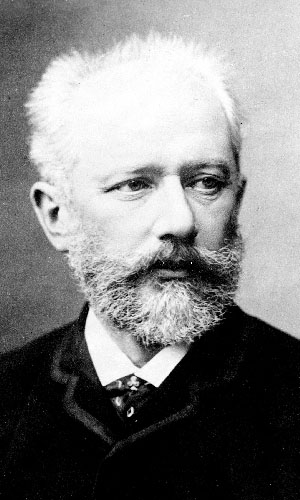 PAINFUL SYMPHONY
PAINFUL SYMPHONY
To regret the past, and hope for the future, never satisfied with the present: that is my life passes.
P. I. Tchaikovsky
This is what the most renowned Russian composer of all times used to say. He was an artist of authentic expression of Romantic provenance whose music enriches the soul and inspires with its timeless sound and melody even a hundred and fifty years after being written. The rich harmony and extraordinary orchestral nuances are the main characteristic of his imposing opus that consists of six symphonies, eleven operas, three ballets, three piano concerts and numerous compositions.
He was born in Votkinsk in 1840 to the middle class family. He expressed interest for music since early childhood but, unlike Mozart, he did not show much potential for it. His family paid much attention to music. Thus, even as a boy, Tchaikovsky was fascinated by music of Mozart, Rossini, Bellini and Donizetti. He was educated at the School of Law in St. Petersburg, but in his free time, he was taking piano lessons. Upon his education, he worked as a civil servant for some time. He left his job when he entered the Conservatory in St. Petersburg. Tchaikovsky studied harmony and counterpoint from Nikolay Zaremba, and orchestration and composition from Anton Rubinstein. He worked as a lecturer at the Conservatory, but the work wore him down and brought up a severe psychological crisis.
The famous composer’s private life was full of psychological breakdowns, wonderings and searches for truth. He was prone to inner restlessness, constant doubts and anguishes. As an introvert and as an extremely emotional person, he created works full of love and passion; some of his works, such as ballet The Nutcracker, have won the hearts of young audiences throughout the world. And yet, his most important symphonies are coloured with deepest emotions of his tormented Russian soul.
There were a lot of controversies regarding Tchaikovsky’s life. Chroniclers and critics often gave superficial accounts about him. His life was portrayed as an emotional nightmare and his character as morbid, neurotic, obsessed with guilt. His suspected homosexuality was a subject of many discussions and analysis. Supposed proof can be found in his letters and journals, but primarily in his problematic and unusual relationship with women that resulted in unconsummated relationships and in his short, unsuccessful, marriage which brought him to the verge of suicide. Ironically, he was officially married until his death. Special part of his life was a platonic relationship with Nadezhda von Meck, who was an admirer of his work and who supported him financially for years. At her request, they never met in person; on two occasions when they saw each other by chance, they did not speak to each other. This curious relationship was maintained through correspondence; there are a thousand and two hundred letters they exchanged in period between 1877 and 1890.
Tchaikovsky, as the first great Russian symphonist, had a special talent for melody and orchestration. Special characteristic of his art is emotionality, namely there is an excellent relationship between his music and audience. The secret lies in his enormous talent with which he managed to transfer joy, love and sorrow, with touching truthfulness, directly to one’s heart. Tchaikovsky is a leading artist of the Romantic period and his works portray Russian character, although he owes a lot to traditions of Italian, French and German music. Stravinsky said that Tchaikovsky was “the most Russian” of them all, but the phenomenon of this ingenious composer is in true synthesis of the Russian spirit and perfect western technique.
Boris Vladimirovich Asafiev, a Russian composer, writer and musicologist, gave an excellent description of Tchaikovsky, “He was the first composer of a new Russian type, absolutely professional, who clearly assimilated tradition of symphonic tradition of western Europe into his deeply original, personal and national style. He unified symphonic approach of Beethoven and Schumann with Glinka’s and he transformed Liszt and Berlioz’s achievements in the sphere of descriptive music into the works of Shakespearian inspiration and psychological significance.”
Tchaikovsky’s final years were very productive. He wrote his best works in this period and he became famous beyond the borders of Russia, throughout Europe and America. His symphonies offer best insight into his unique and ingenious oeuvre – the Second portrays national tradition, the Third shows Schumann’s enthusiasm, the Fourth possesses the elements of humour, while the Fifth portrays religious feelings. The last one, the Sixth Symphony, known as Pathétique or Passionate (there are different interpretations regarding the translation), has foretold the composer’s death. He started composing the symphony in February 1893 and conducted at its first performance on 16th October the same year. Mixed reactions from the audience and critics did not have much effect on his impression that he had created one of his best works. Nine days later, on 25th October 1893, he died of cholera, although there were rumours that he committed suicide. With the Sixth Symphony, he concluded his prolific opus and passed on to eternity.
Brankica Knežević
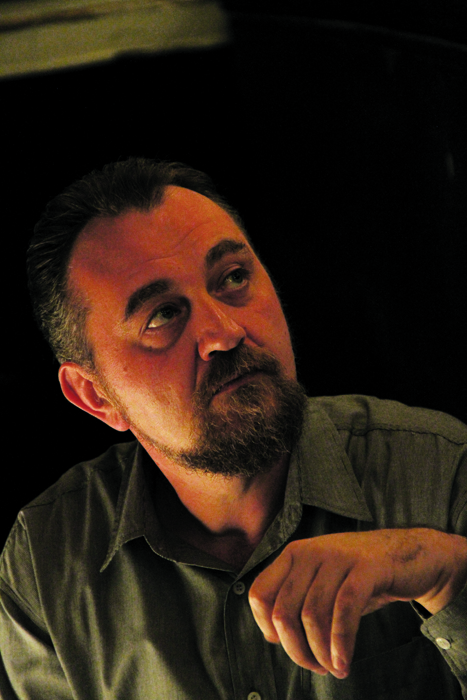 Đorđe Pavlović was born in 1965 in Loznica. He obtained his BA and MA degrees in conducting at the Faculty of Music Art in Belgrade in the class of Professor Jovan Šajnović. Pavlović has been working in the National Theatre Opera since 1992, where he conducted in operas The Bat, The Barber of Seville, The Troubadour, Traviata, Rigoletto, Attila, Nabucco, Don Carlos, Adriana Lecouvreur, La Boheme, Eugene Onegin and balletsThe Sleeping Beauty and The Taming of the Shrew. In period 2000 – 2006, with the Choir of the Opera, Pavlović staged first productions of three comprehensive pieces, Heavenly Liturgy, Liturgy of St. John Chrysostom, and Holiday Evening Service by Svetislav Božić. Besides his work on operatic repertoire, he has been very active in concerts in our country and abroad, where he was engaged in promotion of Serbian music. Some of his performances outside the country were with the Ukrainian Radio Orchestra at Kiev Music Fest, as well as with Oxfordphilomusica Orchestra at the concert in Regent Hall in London. He has been a permanent guest conductor of State Symphony Orchestra from Zaporozje; besides giving numerous concerts with the Orchestra, he also produced a CD with them. Since May 2006, he has been working as a head conductor in Borislav PašćanYouth Philharmonic. He gave numerous concerts with the Youth Philharmonic and won the Gold Plaque of Kolarac’s Legacy Award, at the celebration of 130th Anniversary of the cultural institution (in 2008), and Golden Ring of the Cultural and Educational Community of Serbia for his permanent contribution to culture (in 2009). He belongs to a generation of Serbian conductors who focus their spiritual and artistic growth on incessant source of national music by enriching their repertoire with pieces of spiritually similar music cultures.
Đorđe Pavlović was born in 1965 in Loznica. He obtained his BA and MA degrees in conducting at the Faculty of Music Art in Belgrade in the class of Professor Jovan Šajnović. Pavlović has been working in the National Theatre Opera since 1992, where he conducted in operas The Bat, The Barber of Seville, The Troubadour, Traviata, Rigoletto, Attila, Nabucco, Don Carlos, Adriana Lecouvreur, La Boheme, Eugene Onegin and balletsThe Sleeping Beauty and The Taming of the Shrew. In period 2000 – 2006, with the Choir of the Opera, Pavlović staged first productions of three comprehensive pieces, Heavenly Liturgy, Liturgy of St. John Chrysostom, and Holiday Evening Service by Svetislav Božić. Besides his work on operatic repertoire, he has been very active in concerts in our country and abroad, where he was engaged in promotion of Serbian music. Some of his performances outside the country were with the Ukrainian Radio Orchestra at Kiev Music Fest, as well as with Oxfordphilomusica Orchestra at the concert in Regent Hall in London. He has been a permanent guest conductor of State Symphony Orchestra from Zaporozje; besides giving numerous concerts with the Orchestra, he also produced a CD with them. Since May 2006, he has been working as a head conductor in Borislav PašćanYouth Philharmonic. He gave numerous concerts with the Youth Philharmonic and won the Gold Plaque of Kolarac’s Legacy Award, at the celebration of 130th Anniversary of the cultural institution (in 2008), and Golden Ring of the Cultural and Educational Community of Serbia for his permanent contribution to culture (in 2009). He belongs to a generation of Serbian conductors who focus their spiritual and artistic growth on incessant source of national music by enriching their repertoire with pieces of spiritually similar music cultures.

